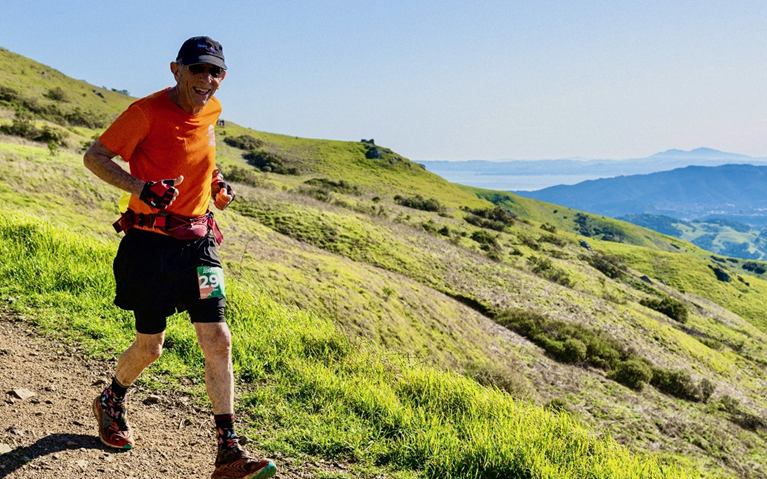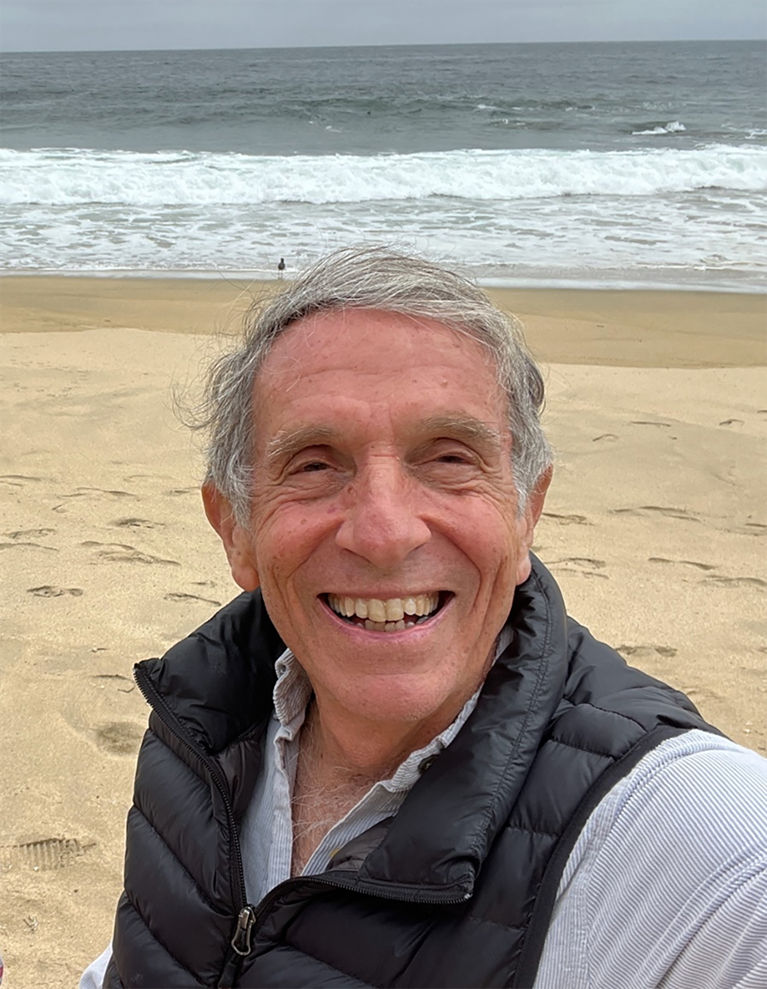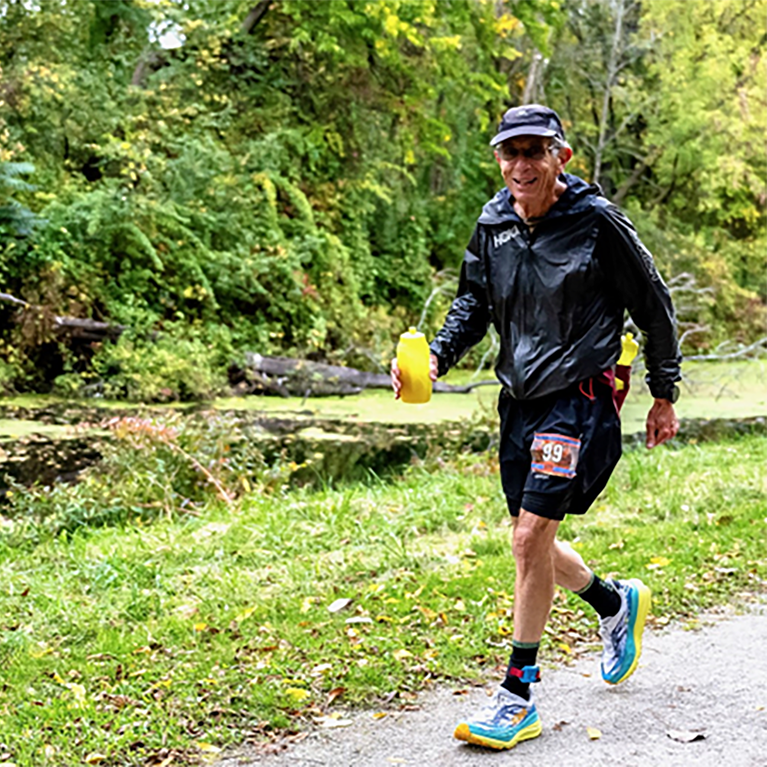
Eric Spector (New York and Mexico City, 1972-76) is not your typical ultramarathon runner.
At age 78, he is challenging perceived limitations of what older people are capable of – and serving as a model of perseverance and inspiration.
In this article, Eric discusses what inspired him to run, what it’s like seeing two sunrises in a 100-mile race, and why he keeps running long trail races – in spite of two recent near-death experiences.
Going the distance
Eric Spector’s journey into ultrarunning began with inspiration from a friend who was running the New York City Marathon.

Two years after having left McKinsey, Eric was at a crossroads. “I was in a place where I had achieved a lot professionally, but I felt like something was missing,” Eric reflects. “I wanted to challenge myself in a different way, to push my limits and see what I was capable of.”
He began training in 1978 and then was off . . . and running. He qualified for and ran his first race in the New York City Marathon just a year later.
Then at age 60, when some people might be thinking of giving up or slowing down on long-distance running, Eric was just starting to pick up steam: that’s when he ran his first ultramarathon, a 50k.
Fast-forward 18 years, and Eric has finished 21 ultramarathons (defined as 50k and above). And he’s still not at the finish line.
A switch to trail running
It was after moving his mail order catalog company from NYC to Marin County that Eric first discovered his love for trail running. “The first time I ran on a trail, I was hooked,” he says. “The combination of the physical challenge and the beauty of nature was something I had never experienced before.”
He continues, “Trail running is very different than road running. While trail running, you have to be alert to the surfaces, rocks, and roots the whole time. You have to prepare: what kind of electrolytes are you taking, and how often. And the weather will vary. I've been in situations where in the middle of a race you go into a new valley and the temperature drops 20 degrees. And you’re running partly in the dark. In a 100-mile race, you see two sunrises.”
Overcoming challenges
Eric’s journey has not been without its challenges. At 78, he faces unique obstacles that younger runners might not. “Age is just a number, but it does come with its own set of challenges,” Eric admits. “Recovery takes longer, and I have to be more mindful of my body. But I’ve learned to listen to my body and adapt my training accordingly.”
One of the most significant challenges Eric has faced is the mental aspect of ultrarunning. “The mental game is just as important as the physical,” he says. “You have to be able to push through the tough moments, to keep going when your body is telling you to stop. It’s a battle of willpower.”
“It's an exhaustion level that is as much mind as body,” he continues. “Of course, it's a very physical test, but it is also an extraordinary mental test to push through it to get to the end. No two 100-mile races are the same. Even if you ran the same course twice, they're not the same experience because the weather has a huge impact.”
Eric adds that there are other elements that factor into the nature of any given race. “How much are you running at altitude? What are the gradients? What is the nature of the trails? Are they rocky? Are they technical? Are they full of roots? You're really essentially running through wilderness.”

Facing danger
Eric has recently even had two near-death experiences while trail running.
“There was a mountain lion about 75 feet from me in the Eastern Sierras that started approaching in the typical cat stalking mode. I was alone, and I picked up a branch with pinecones at my feet and swung it to make myself bigger. Fortunately, he probably wasn’t hungry. ” Eric says.
As if that weren’t enough, less than a year later he got turned around in a wilderness area, also in the Eastern Sierras. While climbing up rock formations to get a view of the lake where he had camped to find his way back, he fell backward into a crevice that he almost couldn’t get out of.
“I could do with no more of those,” Eric says wryly. “Those incidents have caused me to think about going back to some marathon road running.”

Keys to a fulfilling life
“There are really four key things to living a fulfilling life,” Eric says. “One is exercising to maintain your cardiovascular system and overall health. Second, what you put into your body is going to make a big impact on the quality of life that you have. Nutrition matters. Third, sleep is critical, not just for the muscles that need repair, but for the brain’s maintenance. And finally, you need a sense of community. It's very clear that people who have community—that could be family, friends, clubs, charity work, church—live longer.”
Eric explains that the sense of community has been one of the most significant aspects of his journey in the ultrarunning world. “The ultrarunning community is like no other,” he says. “There’s a real sense of camaraderie and support. Everyone is there to help each other, and that makes the experience so much richer.”
It has been a source of strength for Eric, especially during the toughest moments of his races. “When you’re out there for 24 hours or more, you need that support,” he says. “It’s not just about the physical challenge; it’s about the mental and emotional support you get from your fellow runners.”
”It’s about never giving up”
Eric’s journey has taught him valuable lessons that extend far beyond the trails. “Running has taught me the importance of perseverance and resilience,” he says. “It’s not about being the fastest or the strongest; it’s about never giving up, no matter what.”
These lessons have translated into other areas of his life, including his work and personal relationships. “The same principles that apply to running apply to life,” Eric explains. “You have to set goals, work hard, and stay focused. And most importantly, you have to enjoy the journey.”
He continues, “Everyone should have a life goal that’s a reach. It can be whatever you choose and it can be something that you may never even get to, but in the process of moving towards it, you're going to learn a lot about yourself.”
The joy of the journey
Despite the challenges and the dangers, Eric finds immense joy in his running. “There’s nothing quite like the feeling of running through the mountains, feeling the wind on your face, and being surrounded by nature,” he says. “It’s a form of meditation, a way to clear your mind and connect with yourself.”
This joy is what keeps Eric coming back to the trails, year after year. “I’ve run some of the most beautiful and challenging courses in the world,” he says. “Each race is a new adventure, a new opportunity to learn and grow.
“I love that it takes me to places that are spectacular, and the vistas are just amazing. It’s work to get there, though. Some of the races have 10 to 15,000 feet or more of elevation gain. The Western States race has 18,000 feet gain in 100 miles, and more in descent. And the descents are in many cases more difficult than going up because of the exhaustion and different muscles involved.”
Looking to the future
Eric shows no signs of slowing down and has several races on the horizon. “I’m always setting new goals for myself,” he says. “I want to keep pushing myself, to see what I’m capable of.”
Eric says he's hoping to qualify in August for next year's Boston marathon. "I've run it twice, and I’d love to maybe even get to the podium when I reach the 80-84 age group in 2028."
He’s also working on an upcoming book, "Never Stop Running," which he hopes will provide a blueprint for aspiring runners, and help veteran runners keep running by avoiding common mistakes. Running is a privilege and a joy, Eric maintains, especially on trails in spectacular nature locations. “It refreshes the body, mind and soul. It is never too late to start getting fitter.”
For Eric, running is not just a hobby; it’s a way of life. “I’ve found my passion, and I’m not ready to give it up,” he says. “As long as I can run, I will.”
